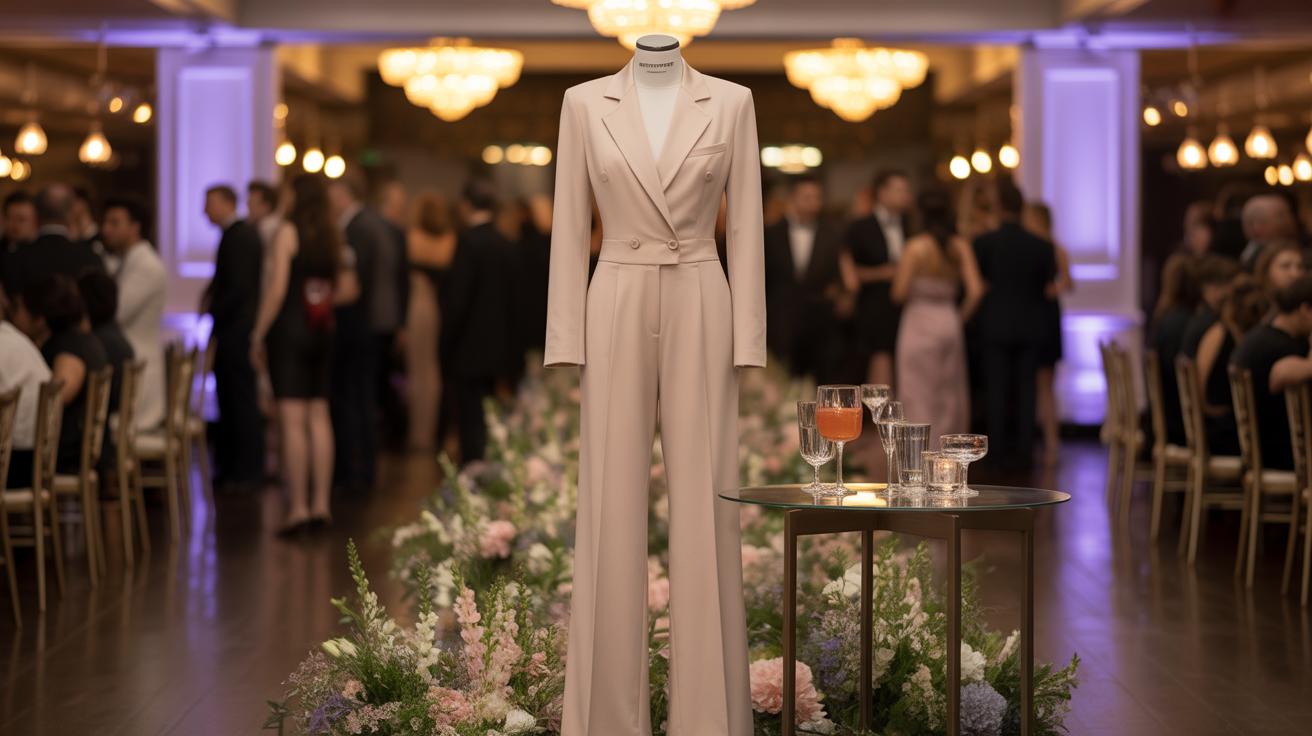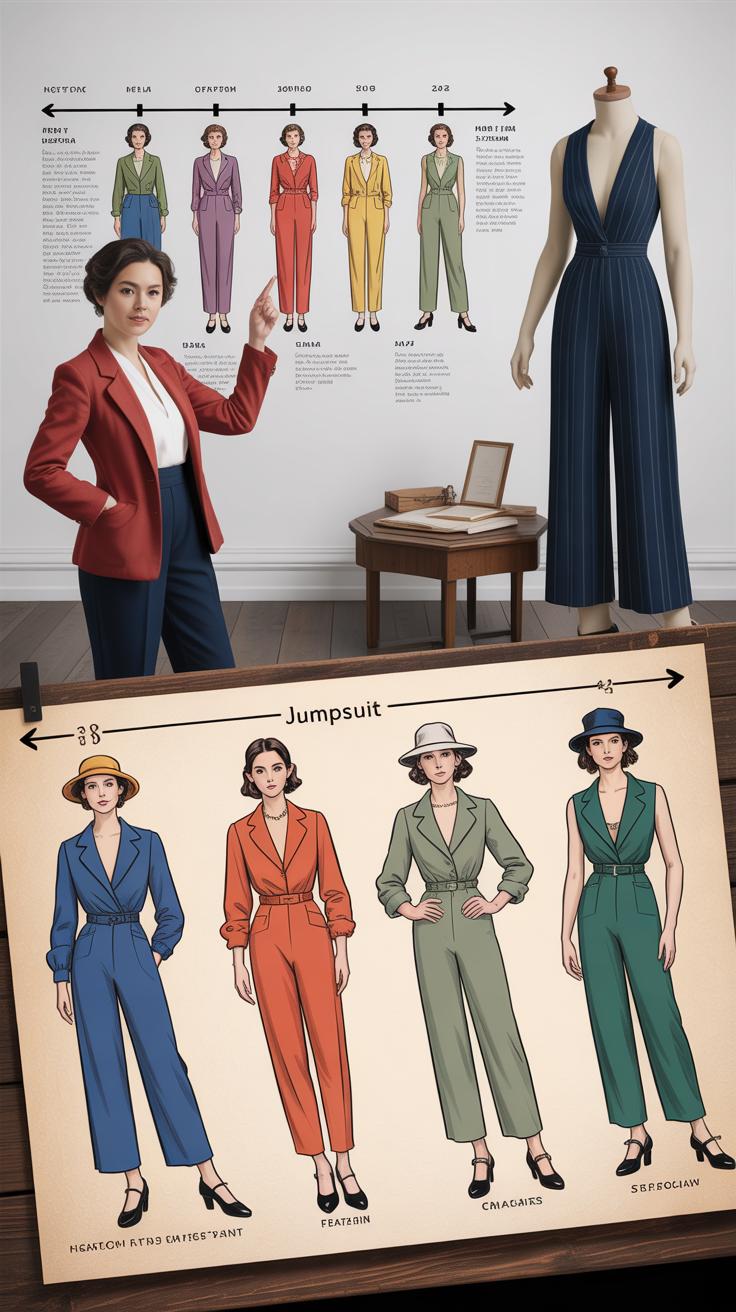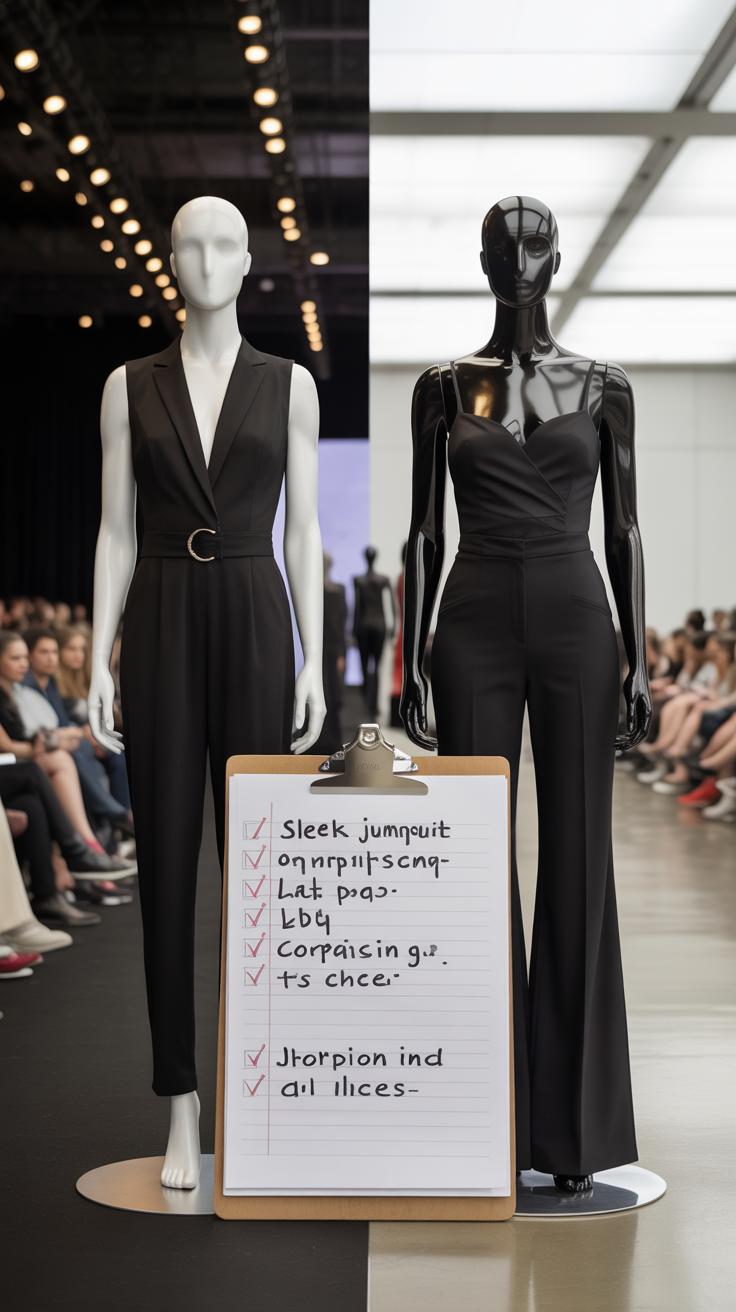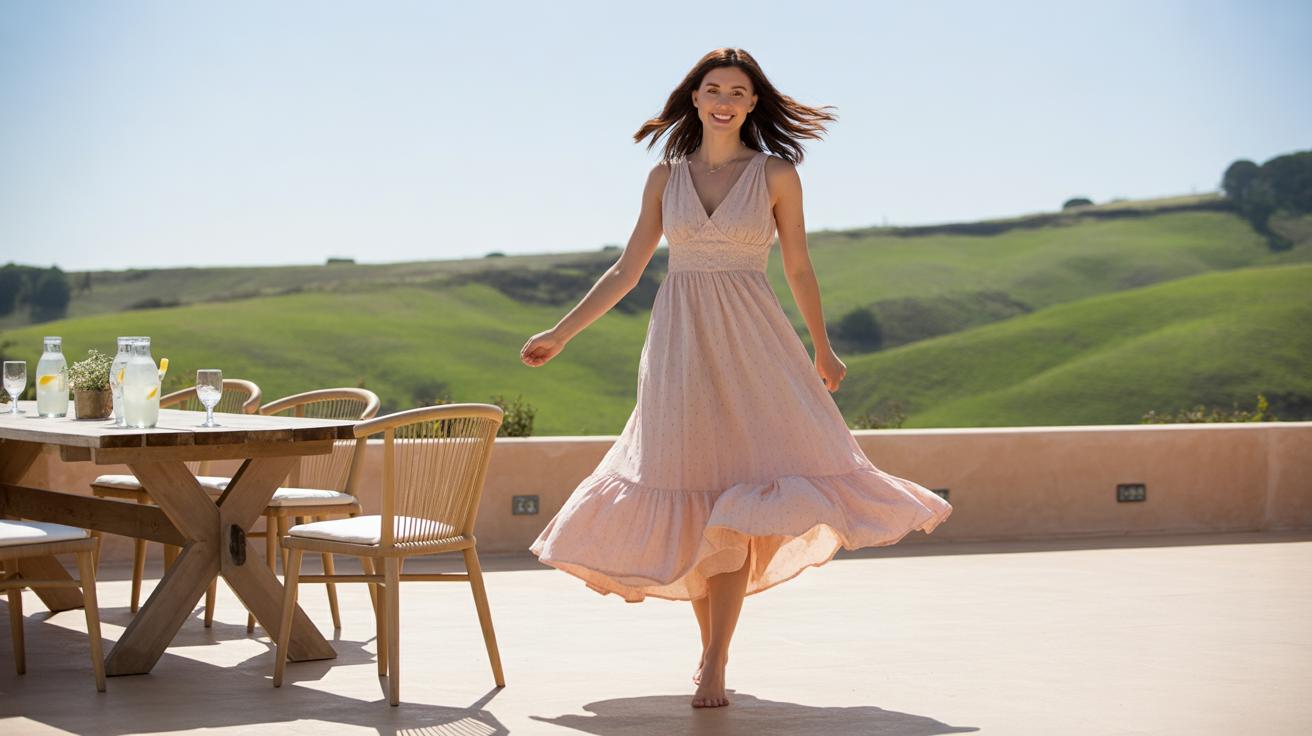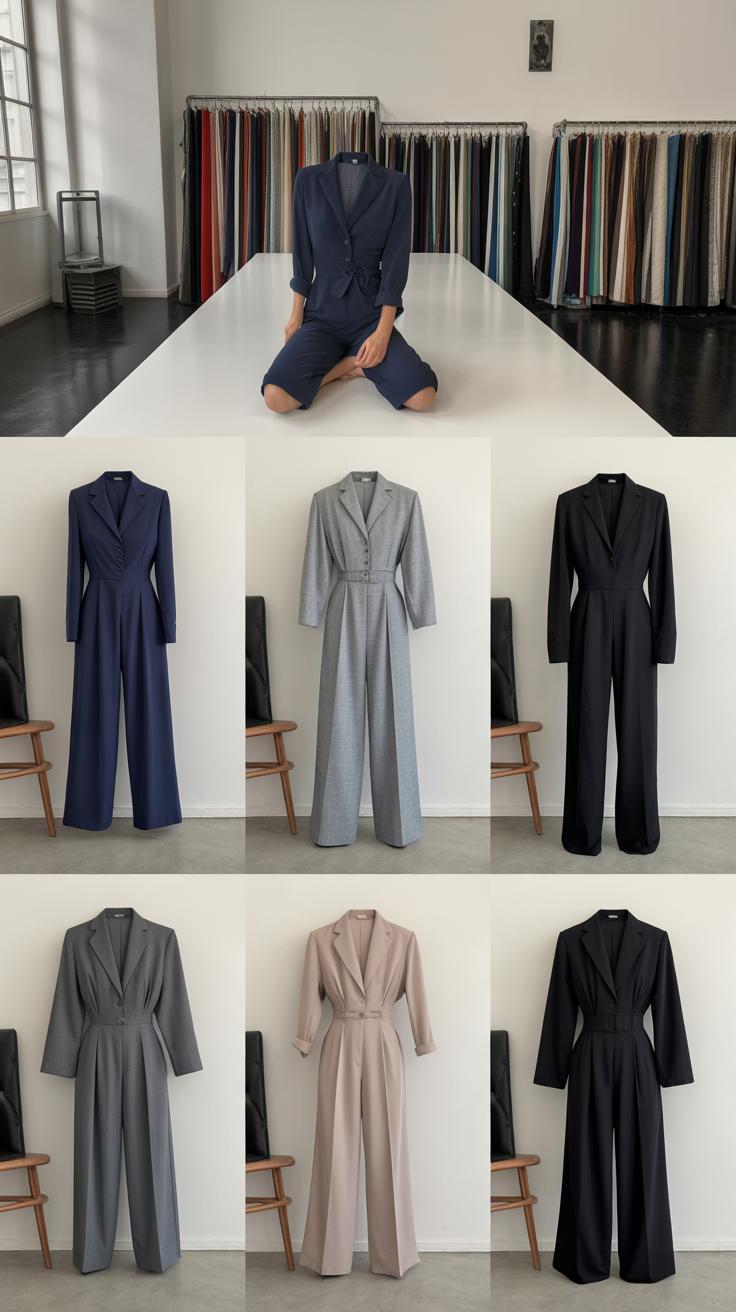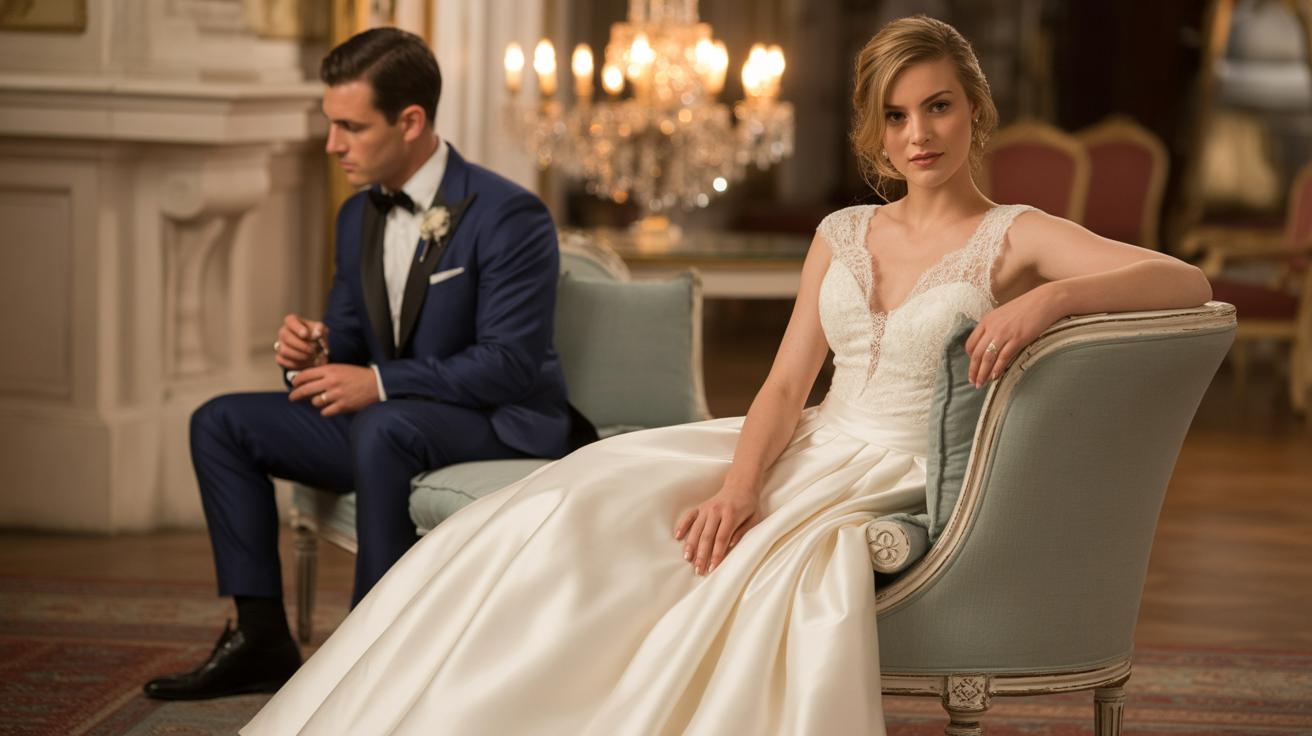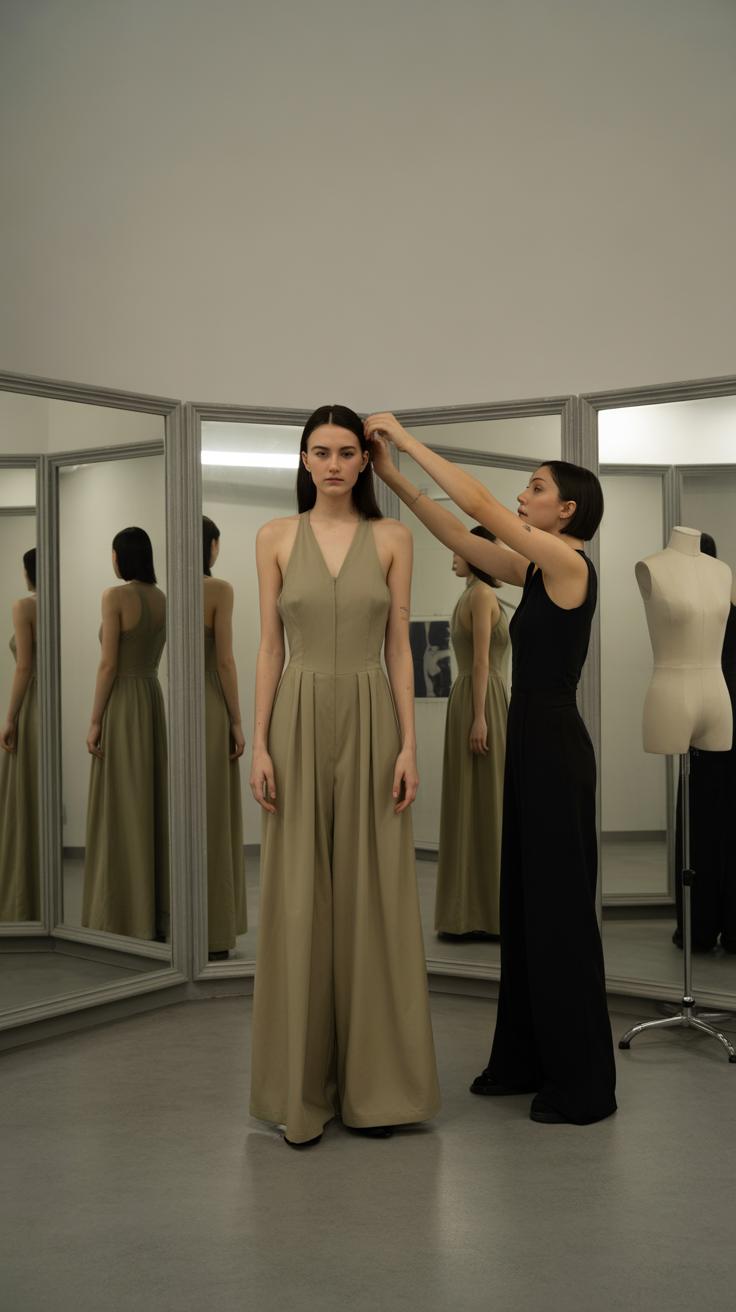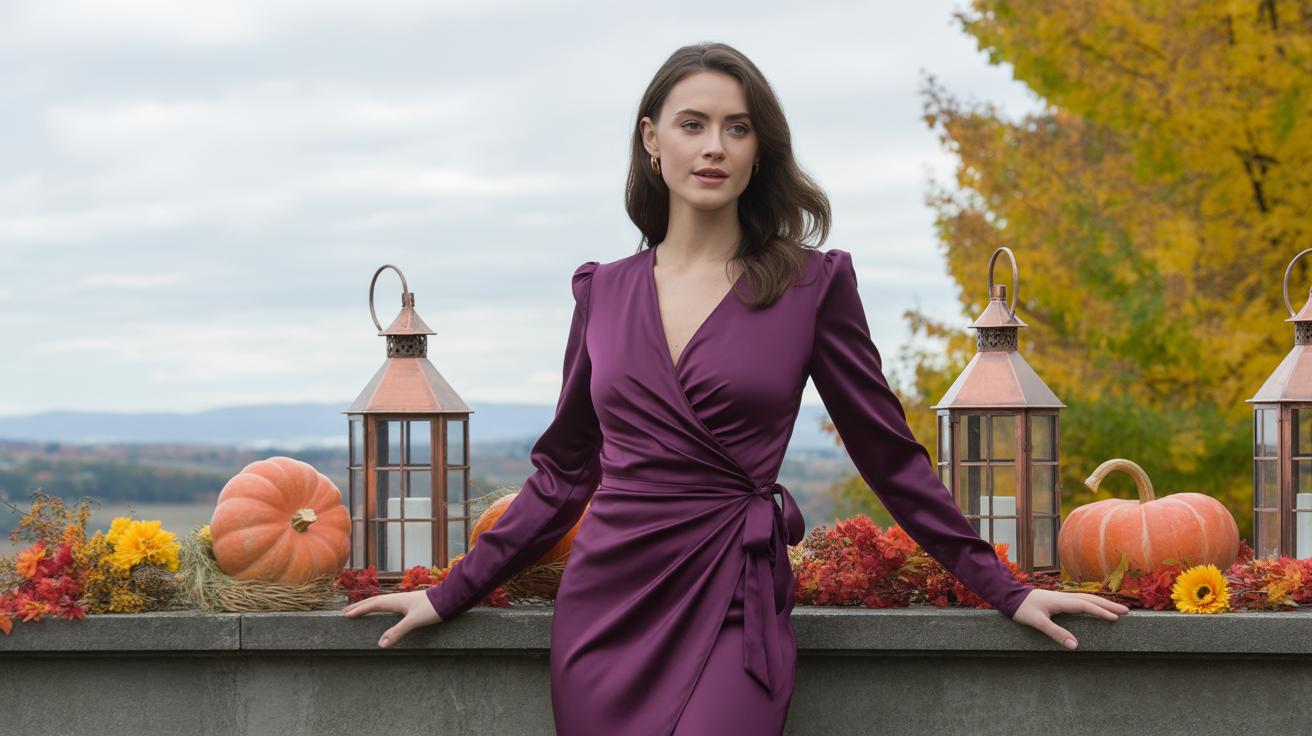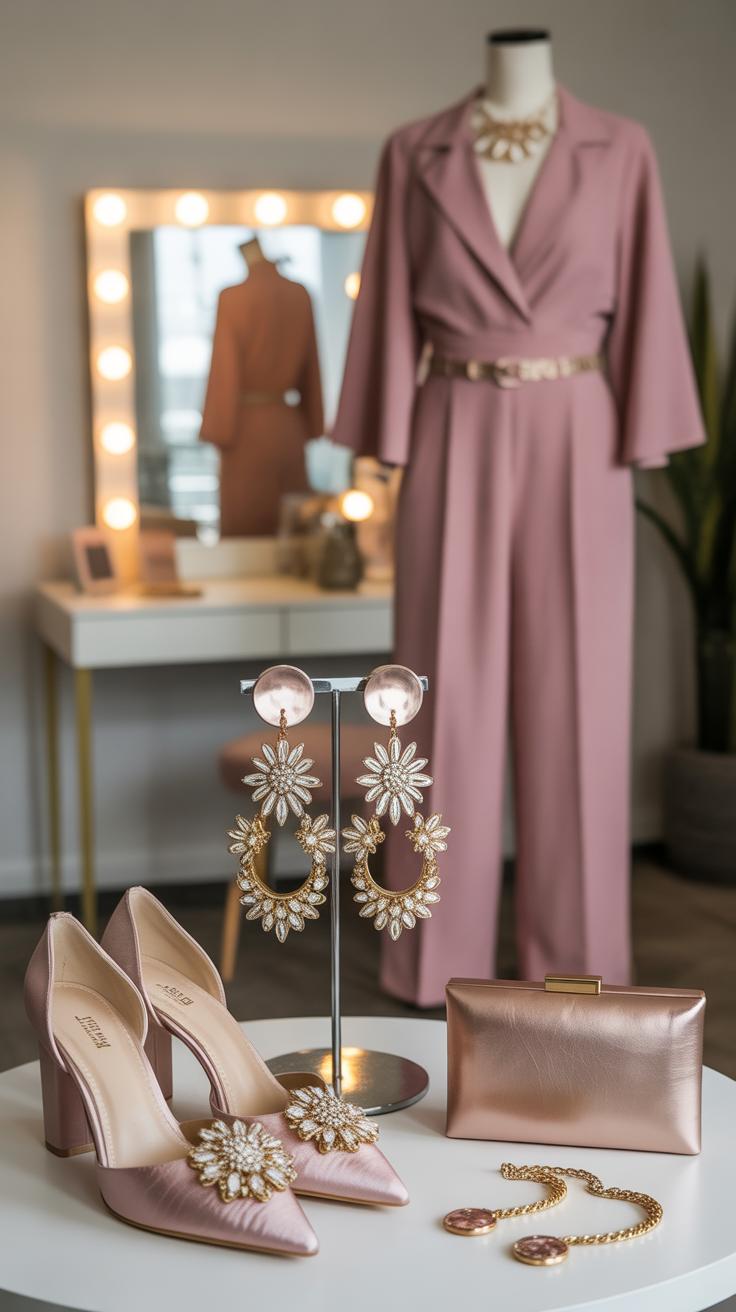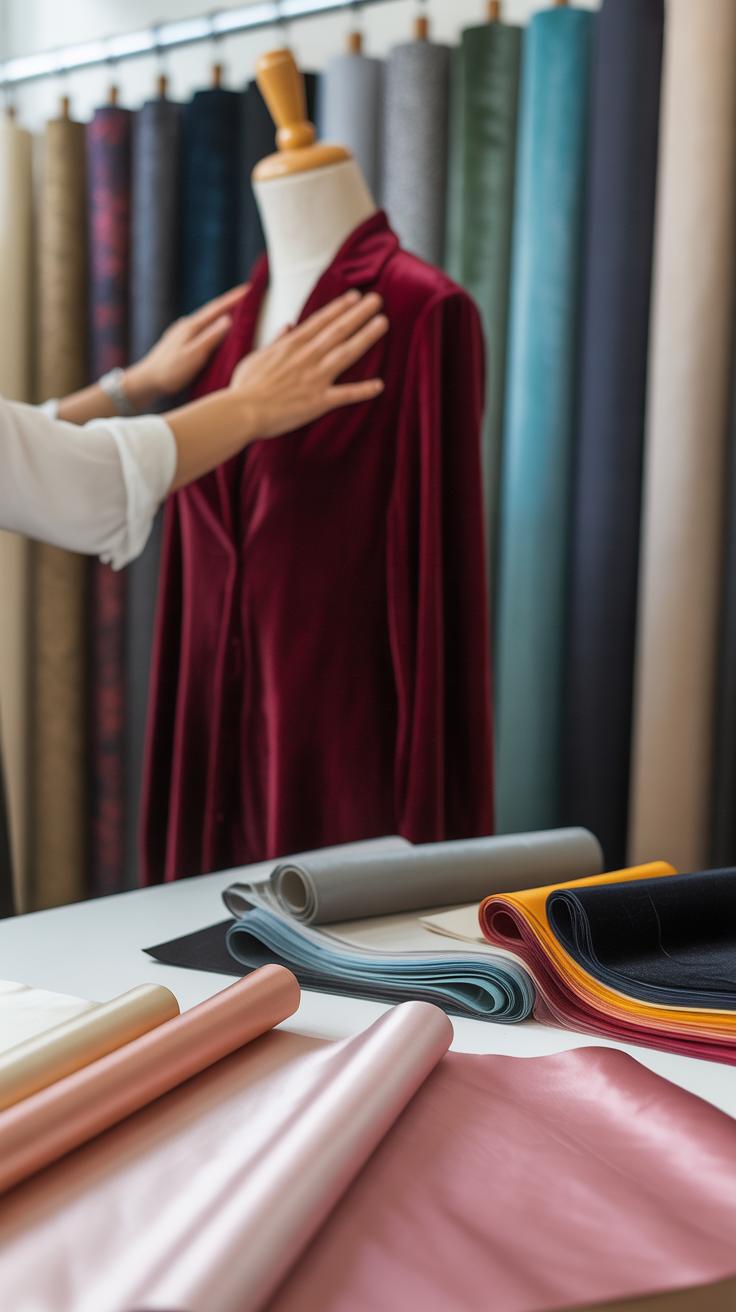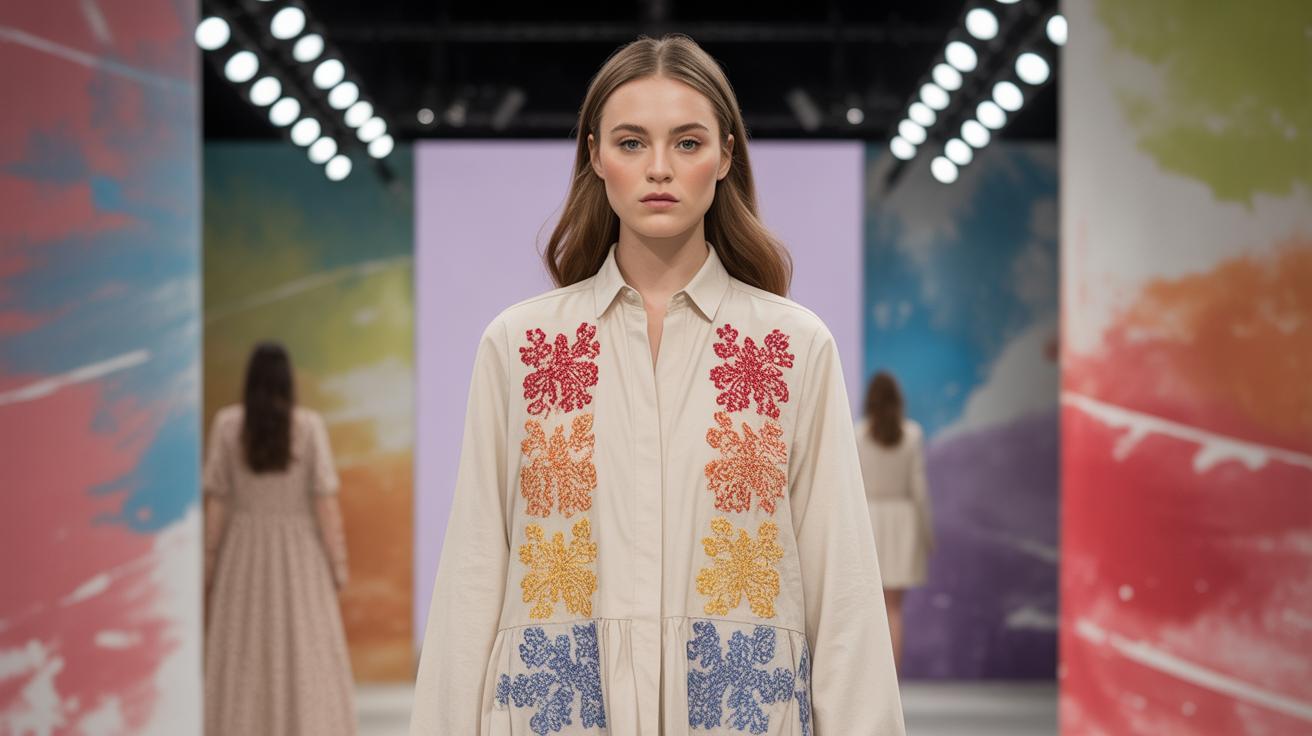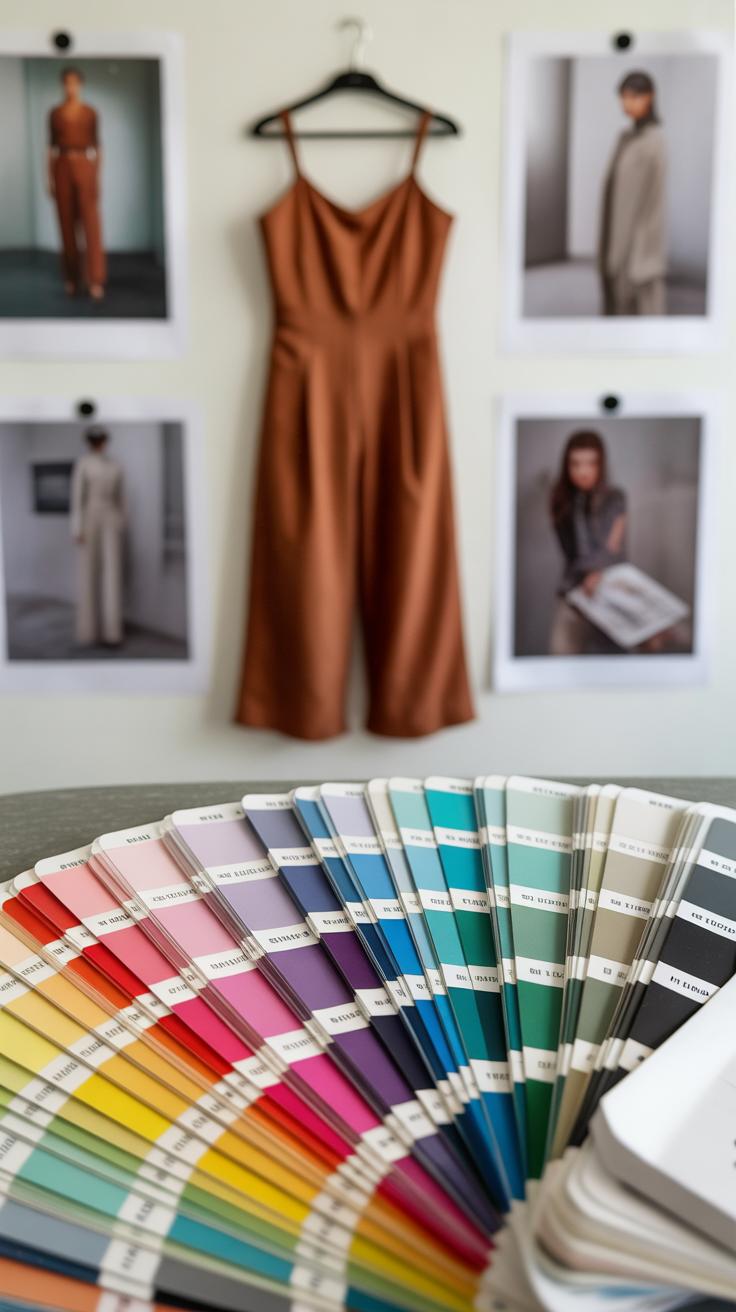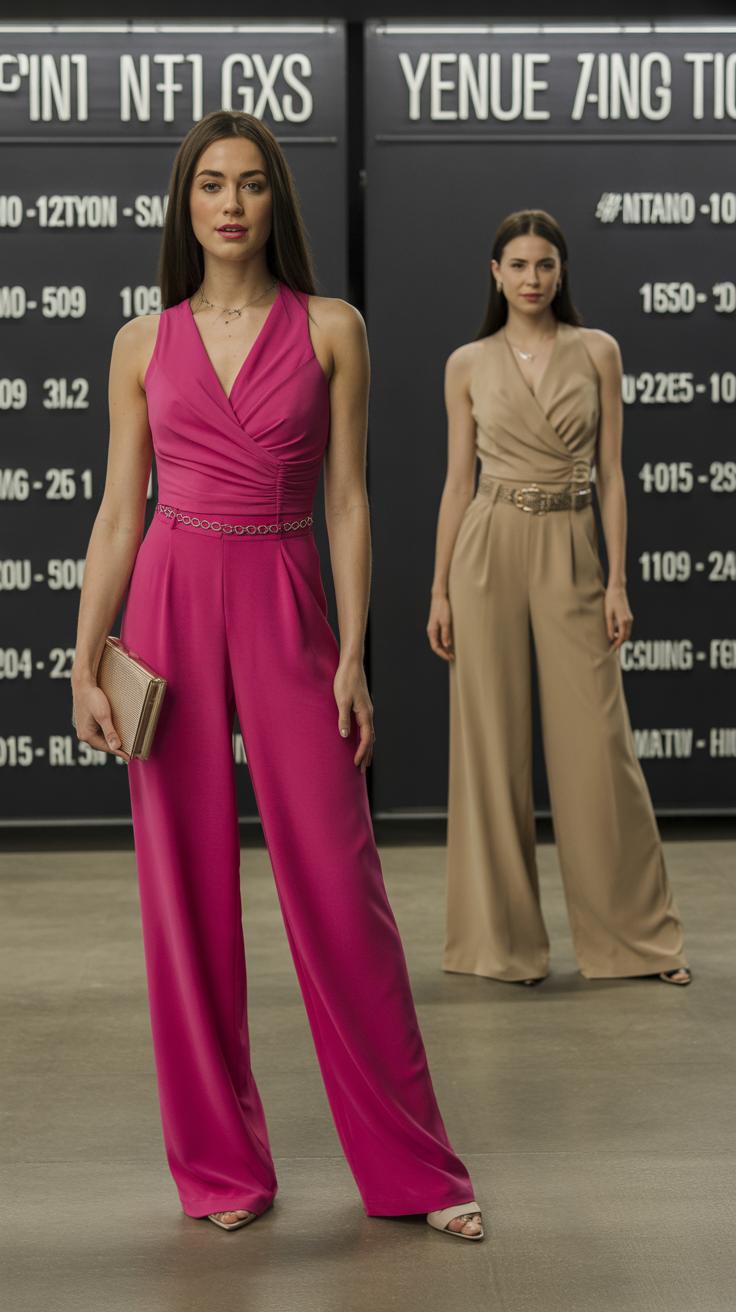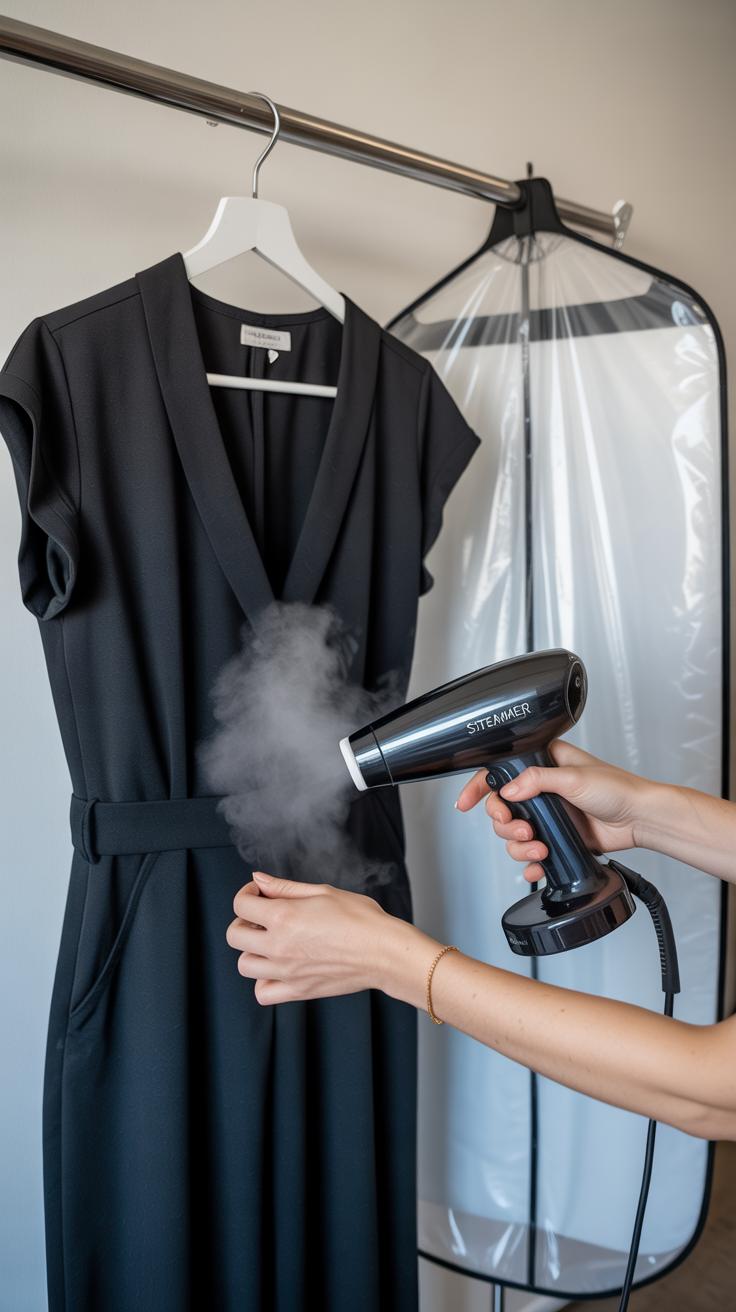Introduction
Formal jumpsuits have grown in popularity as a stylish alternative to traditional formal wear. Their one-piece design offers simplicity and ease without sacrificing elegance. Many choose jumpsuits for events where they want to stand out, presenting a fresh option beyond the classic little black dress. This garment’s versatility encourages creativity in styling and offers comfort for extended wear.
You might be curious about what makes formal jumpsuits a strong contender for your formal wardrobe. Their history as functional garments has evolved into tailored fashion statements. This article explores different formal jumpsuit styles that could redefine your approach to dressing for formal events, providing insights on how to choose the right jumpsuit to fit your style and occasion.
The Evolution of the Jumpsuit to Formal Wear
Origins and Functional Use
The jumpsuit began as practical clothing for parachutists and pilots. Its design focused on safety, with a one-piece shape that kept fabric close to the body. Workers also wore jumpsuits for protection in factories and garages. The garment allowed freedom of movement while covering the entire body. Comfortable fabric choices helped wearers stay at ease during long hours. Functional features like easy zippers and pockets made the jumpsuit reliable for demanding tasks. This utilitarian background shaped the jumpsuit’s simple, sturdy style. Have you noticed how some of today’s formal jumpsuits keep these features but add elegance?
Transition into Fashion
In the 1960s, designers started using jumpsuits as stylish clothing for women. They brought luxe fabrics like silk and satin, changing the rough workwear into something glamorous. Fashion icons like Jacqueline Kennedy and Cher helped make jumpsuits popular on red carpets and in music videos. Yves Saint Laurent introduced tailored jumpsuits with sharp cuts that suited evening wear. These moments showed jumpsuits as smart alternatives to dresses. When you think about dressing for a special event, can a designer jumpsuit offer a new way to stand out?
Why Choose a Formal Jumpsuit Over a Little Black Dress
You might ask why a formal jumpsuit deserves a place in your wardrobe instead of the reliable little black dress. Formal jumpsuits provide comfort that dresses often cannot match. When you attend events that last for hours, unrestricted movement can make a significant difference in your experience.
Also, jumpsuits offer a fresh, fashion-forward look. They break away from tradition and let you express your style in a modern way. Since designers use different cuts and fabrics, you can find a jumpsuit that suits your personality and the formality of your event.
Think about your needs. Would you prefer freedom of movement during a party or sitting comfortably through a dinner? Do you want a piece that stands out but still feels elegant? A formal jumpsuit could easily replace your go-to dress by meeting these needs without compromising style.
Comfort and Practicality
Formal jumpsuits often use stretchy or soft fabrics that move with you, unlike some dresses that can feel tight or require constant adjusting. They cover you completely, so issues like a strap slipping or a skirt riding up do not come into play.
During long events, you want to focus on enjoying yourself—not on fixing your outfit. Jumpsuits let you move easily whether you are dancing, sitting, or walking. Many include hidden zippers or elastic waistbands that make putting them on and taking them off simple.
Do you find yourself hesitant to wear a dress that restricts movement? Choosing a jumpsuit can solve that problem without sacrificing sophistication. Comfort does not have to mean casual—formal jumpsuits prove that well.
Styling Versatility
You can wear the same jumpsuit to different occasions by changing how you style it. For example, pairing a tailored jumpsuit with heels and pearl earrings creates a classic formal look perfect for a wedding.
Swapping accessories can also transform the vibe. A bold belt and statement clutch make a jumpsuit ideal for cocktail parties, while a sleek jacket and simple jewelry tone it down for business formal events.
Because jumpsuits come in various cuts—from wide-leg to fitted—you have many options to suit your body shape and the occasion. Which type of jumpsuit would suit your style best? Exploring these choices can help you build a flexible wardrobe that works for many events.
Key Formal Jumpsuit Styles to Know
Formal jumpsuits come in many styles that stand as strong alternatives to the little black dress. Tailored jumpsuits offer sharp, clean lines that bring a polished and professional vibe, perfect for corporate events or formal dinners. These styles often have fitted waists and straight legs, flattering hourglass and rectangular body shapes.
Wide-leg jumpsuits add drama and movement while elongating the legs. They work well for pear-shaped or tall figures, creating balance between shoulders and hips. Cut-out designs introduce edge and modernity, showcasing a bit of skin without sacrificing elegance.
Embellished jumpsuits with beads, sequins, or lace bring glamour and draw the eye, ideal for festive or evening occasions. Those who prefer simplicity may lean toward monochrome jumpsuits in solid colors. These create sleek silhouettes and can suit almost any body type by focusing attention on fit rather than pattern.
Tailored and Structured Styles
Sleek tailored jumpsuits give you the sharp lines of a formal suit with the ease of a one-piece outfit. Their clean cuts and fitted waistlines create a strong silhouette that works well in boardrooms or upscale dinners. You can find styles with lapels, button details, and tapered legs to replace the traditional dress uniformly.
These jumpsuits fit best on those who want to emphasize a defined waist and prefer a minimalist look. If you like sharp details and high structure, tailored jumpsuits offer professionalism with an updated twist. How could your wardrobe change if you swapped a dress for a tailored jumpsuit at your next event?
Embellished and Unique Details
Jumpsuits with embellishments, lace, or special cut-outs highlight your style at evening events. Sparkling beadwork or metallic thread turns a jumpsuit into a showstopper. Lace inserts offer a soft contrast to strong cuts while keeping the outfit formal.
Styles with unique necklines or asymmetrical designs let you stand out without trying too hard. These choices fit those who want their outfit’s details to express personality. Would you choose an embellished jumpsuit to make a statement instead of a classic black dress?
How to Select the Right Formal Jumpsuit for Your Figure
Choosing a formal jumpsuit that suits your body starts with understanding your shape and what features to highlight. Waist definition plays a big role. If you want to show off your waist, look for jumpsuits with belts or cinched waists. For shapes that carry weight in the midsection, jumpsuits with relaxed or empire waists can create a smoother line.
Leg cut changes the look too. Wide-leg styles can balance out wider hips, while tapered or straight legs work well on slimmer legs. Neckline shapes affect your upper body’s appearance. V-necks lengthen the neck and slim the bust, while high necklines draw attention upwards.
Fabric choice affects how the jumpsuit falls on your body. Heavier fabrics hold structure, which is helpful for a tailored look. Lighter fabrics suit looser styles but may need lining to avoid clinging. Think about your comfort and the event. Choosing the right jumpsuit makes you feel confident and poised.
Consider Your Body Shape
Hourglass figures shine in jumpsuits that emphasize the waist with fitted designs. A wrap-style or belted jumpsuit enhances natural curves.
Pear-shaped bodies benefit from wide-leg pants that balance hips with shoulders. Look for tops with details like ruffles or boat necks to add volume to the upper body.
Apple shapes shape well in jumpsuits with looser midsections and defined legs. High waistbands and straight legs shift focus away from the stomach.
Rectangular bodies gain definition with jumpsuits that add shape. Peplum styles or jumpsuits with waist details create curves. Experiment with necklines to add dimension to your frame.
Mind the Fit and Fabric
Fit means comfort and style working together. Avoid jumpsuits that pull tightly in uncomfortable areas, as they can ruin your posture and confidence. Make sure you can sit and move easily.
Fabrics like crepe or matte satin provide a formal look without stiffness. Stretch fabrics offer ease but check that they don’t cling to areas you want to minimize.
Consider jumpsuits with linings or structured panels for a polished look. Avoid slippery fabrics if you want the jumpsuit to hold its shape. At the same time, breathable fabrics keep you comfortable during long events.
Reflect on the occasion and your personal comfort to pick a jumpsuit that fits well and feels right on your skin. How does your chosen fabric move when you walk? How does the fit improve your confidence? These questions guide your selection.
Accessorizing Your Formal Jumpsuit
Accessories can change how your formal jumpsuit looks and feels. Choosing the right jewelry, belts, shoes, and bags will help you create a polished outfit. You should pick pieces that match the style of your jumpsuit and suit the occasion. For example, a sleek jumpsuit with a deep V-neck pairs well with delicate jewelry that highlights the neckline without overpowering it. Adding a belt can mark your waist and give structure to loose or flowy jumpsuits.
Shoes and bags should balance the outfit’s proportions. A tailored jumpsuit with wide legs looks good with heels that add height. If the jumpsuit is fitted, you could choose flats or low heels for comfort. Think about where you’re going and how much you’ll be moving around. Your accessory choices give you a chance to add your personal touch. How will you use accessories to make your formal jumpsuit truly yours?
Jewelry and Statement Pieces
Necklaces, earrings, bracelets, and rings can shape the look of your jumpsuit, especially around the neckline. If your jumpsuit has a strapless or off-shoulder style, bold earrings and a chunky bracelet draw attention to your face and arms. For high-neck jumpsuits, avoid necklaces and instead wear statement earrings or stack rings to add flair. Thin chains and subtle studs work well with plunging necklines, letting the jumpsuit remain the focus.
Consider how jewelry works with your fabric and color choices. Shiny metals suit satin, while matte finishes complement crepe or velvet well. Statement pieces can bring personality to solid-colored jumpsuits, while simple designs prevent busy patterns from feeling overdone. When you select your jewelry, ask yourself if it highlights your jumpsuit’s strongest features and reflects your own style.
Shoes and Bags Tips
The shoes and bag you pick will complete your formal jumpsuit look. Heels often work best with jumpsuits because they lengthen your legs. However, block heels or pointed flats can be stylish and keep you comfortable. Match your shoe color to your jumpsuit or accessories for a cohesive look. Avoid bulky shoes with slim, flowy jumpsuits, as they can imbalance the silhouette.
Bags should be sized to the event. A small clutch or a sleek crossbody fits formal evenings, while structured totes work for day events. Choose bags with clean lines and minimal detailing to keep the look elegant. Think about how you will carry your essentials and whether the bag’s style complements your jumpsuit’s cut and material. Have you tried mixing shoe and bag styles to express your unique fashion sense?
Fabric Choices That Define Formal Jumpsuits
Fabric plays a key role in how formal a jumpsuit looks and how comfortable it feels. When selecting your jumpsuit, think about the texture and weight of the material. Silk offers a smooth feel and natural shine, perfect for an elegant look. Satin also shines but has a heavier weight that holds shape well, making it suitable for structured designs. Crepe has a matte finish and a soft drape, adding subtle sophistication without too much sheen. Velvet stands out with its rich texture and depth, ideal for winter events.
Lightweight fabrics like silk and crepe can keep you comfortable during long evenings. Heavier ones like velvet might feel warmer but give a luxurious touch. Consider how easy the fabric is to clean. Silk often needs gentle washing, while crepe can be more durable. Choosing the right fabric protects your investment and helps you maintain a sharp, polished look throughout your event.
Formal Fabrics and Their Features
Silk drapes smoothly and shines softly, creating a graceful flow that suits flowing jumpsuit styles. Satin reflects light strongly with a glossy surface that adds drama to your outfit. Crepe offers a slightly textured feel with minimal shine, lending a modern yet understated vibe. Velvet stands apart with its soft, plush surface and deep color saturation, making it perfect for formal occasions during colder months.
Each fabric’s quality affects not only how the jumpsuit looks but also how it moves with you. Silk allows fluid movement, enhancing comfort. Satin holds structure well for tailored fits. Crepe works for both loose and fitted designs due to its moderate stretch. Velvet’s thickness can add warmth but may limit breathability. Knowing these features helps you choose a jumpsuit fabric that works best for your style and event.
Maintenance and Practicality
Think about how you will care for your jumpsuit fabric before making a final choice. Silk requires delicate hand washing or dry cleaning to avoid damage. Satin also needs careful cleaning to keep its glossy finish intact. Crepe tends to handle regular dry cleaning well and resists wrinkles, making it easier to maintain. Velvet often demands dry cleaning and careful storage to prevent crushing its pile.
Fabric weight affects comfort during long events. Lightweight silks keep you cool but may crease easily. Heavier velvets keep warmth but can feel heavy by the end of the night. Plan ahead for how you will clean and store your jumpsuit. Choosing a fabric that fits your lifestyle and event length ensures your outfit will look fresh and flawless from the start to the last dance.
Colors and Patterns for Formal Jumpsuits
The color and pattern you choose for your formal jumpsuit can change the entire look and feel. Classic colors like black and navy give a timeless, polished appearance. They are easy to style and fit almost any formal event. Jewel tones such as emerald, sapphire, and ruby offer a rich look that adds depth without overwhelming. These colors often complement a variety of skin tones and feel special without being too loud.
Bolder colors like red or cobalt can make a statement but require careful pairing with your complexion and the event’s vibe. Subtle patterns, like tone-on-tone designs or soft geometric prints, provide interest without distracting. Monochrome jumpsuits in off-white or blush create a refined and modern look. When picking a color, consider the event setting—will it be outdoors or indoors? Day or night? Think about what colors enhance your skin’s natural tones to highlight your best features.
Classic and Safe Color Choices
Black remains the go-to for many formal occasions because it suits almost every body type and skin tone. It feels sleek and can be matched with any shoes or accessories. Navy offers a softer alternative to black while still feeling formal and elegant. These colors rarely clash with event themes or dress codes. Choosing them means less stress about standing out too much and more confidence in your look. They also photograph well and tend to hide minor wrinkles or stains that might occur during a busy evening.
Bold Colors and Patterns
Bold colors like red, emerald green, or royal blue can help you stand out. Your best choice depends on your skin tone—warm tones pair well with oranges and yellows, while cool tones suit blues and purples. Patterns don’t have to be loud to be stylish. Subtle prints like pinstripes, lace textures, or muted floral designs add interest but keep the look formal. When wearing bold colors or patterns, keep your accessories simple to maintain balance. Consider the event’s formality; a business gala calls for more conservative choices than a wedding or art opening.
Styling Tips for Different Formal Events
The right formal jumpsuit can transform your look for weddings, galas, dinners, or corporate parties. Consider the event’s dress code before selecting your outfit. For black-tie events, choose tailored jumpsuits with refined details, such as sleek necklines or a subtle train. Pair these with elegant heels and statement jewelry to match the evening’s glamour.
Weddings call for softer silhouettes and fabrics that move gracefully. Light colors or delicate patterns work well here, paired with minimal accessories to avoid overshadowing the celebration. For corporate parties, aim for structured designs that give a polished appearance. Neutral colors and a simple belt can enhance your professional look without looking too formal.
Think about the time and setting when styling your jumpsuit. Outdoor dinners may need practical footwear and a stylish wrap, while indoor galas allow for bold accessories. Ask yourself if your outfit expresses the right level of respect and style for the occasion. Matching your jumpsuit to the event’s mood helps you feel confident and appropriate.
Adapting to Event Formality
Not all formal events demand the same look, so tailor your jumpsuit accordingly. For strict black-tie, narrower trousers and luxe fabrics like silk elevate your style. Less formal occasions let you experiment with wider cuts or playful details like ruffles.
Accessorize based on event tone to balance your appearance. Heavy sequins work for glamorous galas but may look overwhelming at corporate mixers. Simple jewelry and classic pumps resonate well in professional settings. Your choice of clutch or handbag can also signal how formal your outfit feels.
Seasonal Styling Considerations
Choose fabrics suited to the season for comfort and style. Lightweight materials like chiffon or crepe work best for spring and summer, allowing your skin to breathe. In cooler months, opt for heavier textiles such as velvet or wool blends to keep warm.
Layer smartly by adding tailored blazers or shawls that complement your jumpsuit. Darker colors fit fall and winter seasons, while bright or pastel shades brighten spring and summer events. Ask if your jumpsuit meets both warmth and style needs for the season to avoid discomfort.
Caring for Your Formal Jumpsuit
How do you keep your formal jumpsuit looking fresh and new? The key lies in proper care to preserve its shape, color, and fabric quality. Handling your jumpsuit gently after wearing it can prevent wrinkles and fabric stretching. Avoid pulling on seams or delicate embellishments when putting it on or taking it off.
Pay attention to the fabric type. Lightweight materials like silk or satin require more delicate treatment, while heavier fabrics like crepe might be easier to manage. Spot clean minor stains promptly with a mild detergent to avoid setting the stain. Avoid harsh rubbing that can damage fibers.
Think about your jumpsuit as an investment in your wardrobe. How you treat it after a special event influences how many times you can wear it in the future. Proper care extends its life, keeping you confident in a look that challenges the little black dress.
Cleaning and Maintenance
Check the garment tag for cleaning instructions before washing. Many formal jumpsuits require dry cleaning to keep fabrics and colors intact. Hand washing can work for some materials, using cold water and gentle detergent. Never use bleach or strong chemicals as they can fade or weaken the fabric.
If your jumpsuit gets stained, act quickly. Blot the stain rather than rubbing it. For oily spots, sprinkle baking soda to absorb grease before gently brushing it off. Allow your jumpsuit to air dry after cleaning. Avoid wringing out water, which can distort shape.
Regular upkeep includes airing out the jumpsuit after each use to reduce odors and light creasing. Iron or steam the fabric carefully to restore smoothness, using a low temperature to protect the fibers. Proper cleaning prevents buildup that dulls your jumpsuit’s appearance.
Storage and Handling
Storing your formal jumpsuit properly stops wrinkles and fabric damage. Hang your jumpsuit on a padded hanger to support the shoulders and maintain its shape. Avoid wire hangers that can leave marks or cause distortion.
Cover the jumpsuit with a breathable garment bag to protect it from dust and light. Avoid plastic covers which trap moisture and increase the risk of mildew. Store it in a cool, dry place away from direct sunlight to prevent fading.
Folding your jumpsuit flat is an option for travel, but place tissue paper inside folds to reduce creasing. Check your jumpsuit periodically during storage. Small actions like these will keep the outfit ready for the next time you opt for a formal jumpsuit over the classic little black dress.
Incorporating Formal Jumpsuits into Your Wardrobe
Formal jumpsuits suit a wide range of special events. You can wear them instead of the usual dress without losing elegance or style. Think about mixing jumpsuits with your existing formal pieces to create fresh looks. Pair a sleek jumpsuit with a classic blazer for a polished appearance, or add a statement belt to highlight your waist.
Building your wardrobe with jumpsuits in mind means choosing styles that fit your body and personality. Opt for neutral colors at first, like navy or deep green, to maximize their use. Then, bring in pieces with unique cuts or patterns to stand out.
How often do you try a new style just because it feels fresh? Your jumpsuits can be that new piece that boosts your confidence during special occasions. With time, they might become your go-to choice for formalwear, offering comfort and an updated look that dresses can’t always provide.
Versatility and Wardrobe Planning
Mixing jackets, shoes, and accessories with your jumpsuit creates different vibes. A tailored blazer adds structure, while a leather jacket can introduce edge. Swap heels for stylish flats or ankle boots to change comfort levels without losing style.
Accessorize with bold jewelry for an eye-catching look or keep it simple with minimal pieces for subtle charm. Changing your belt or adding a scarf can refresh the jumpsuit for another event. Think of your jumpsuit as a base and build layered outfits around it.
Do you have staples in your closet that transform with just a few changes? Use this idea for your jumpsuits to stay versatile and always ready for any dress code.
Keeping Your Style Current
Trends in formalwear shift, but your style doesn’t have to change completely. Update your jumpsuit wardrobe by adding modern details like puff sleeves, cutouts, or unique fabrics. These details keep your look fresh but still personal.
Changing up your shoes or accessories can also keep you on trend. For example, swap classic pumps for block heels or strappy sandals that are popular now without sacrificing elegance.
Ask yourself which trends fit your lifestyle and personality. Can a new neckline or color brighten your collection? When you add trendy pieces thoughtfully, your jumpsuits stay current and reflect who you are.
Conclusions
Formal jumpsuits present you with a practical yet fashionable choice that breaks away from traditional dress options. They combine comfort and style, making them suitable for a range of formal events. With various cuts and details, these pieces allow you to express personal style while maintaining elegance.
Consider the formal jumpsuit as a versatile investment for your wardrobe that can adapt to changing trends and occasions. By selecting styles that flatter your figure and suit the event, you can enjoy both confidence and ease. Why stick to the familiar when you can add a modern twist to your formal wear collection?


